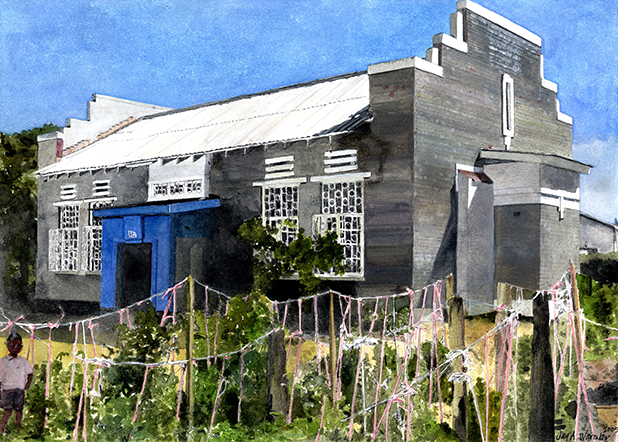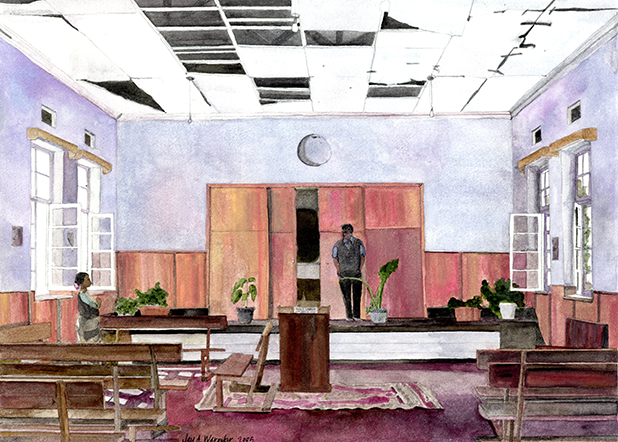 Exterior View (2005), 15” x 11” Watercolor, Jay A. Waronker
Exterior View (2005), 15” x 11” Watercolor, Jay A. Waronker
ZAMBIA
Former Mufulira Hebrew Congregation Synagogue (Completed in 1946) |
|

Interior View (2005), 15” x 11” Watercolor, Jay A. Waronker
|
It was World War II, and the influx of Jewish refugees which preceded its outbreak, which provided the greatest stimulus for the creation of a more sizeable and sustainable Jewish population in Zambia. With this came the realization of various tangible religious institutions throughout the country, including synagogues as well as social hall, schools, and cemeteries. Along with Jewish communities in the capital city of Lusaka and at Livingstone to the south, Jews settled in Copperbelt Region in central Zambia. There the discovery and exploitation of the valuable mineral in the early twentieth century resulted in an explosion of economic activity. The massive deposits of copper could be said to be the true reason for Zambia’s allure to European imperialism and its overall existence, and Zambian mines came to supply the industrializing world’s demand for such an important natural resource. While Jewish involvement in the actual mining industry was limited, Jews quickly set up tangential businesses in this region, particularly in the areas of real estate development, trade, service, and transportation. Town centers featured buildings built by Jews, including offices, shops, hotels, and department stores.
Among the synagogues built in the Copperbelt Region was one in Mufulira, the smallest and northernmost of the places where Jews established themselves. In contrast to other area cities, Mufulira’s Jews were engaged in the mining trade, and for that reason they were considered a more cohesive group. Their synagogue was built in the Mufulira Central district on a generous plot of land acquired by the community around 1945, and construction began that same year. An early construction ceremony was held by the congregation when they deposited some type of time capsule in one of incomplete walls. By early 1946, work on the synagogue had been completed. It was built as a multi-purpose facility containing a sanctuary, social hall, offices, school, and support spaces.
The architect of the building, who designed a modest and heavy-feeling structure with stucco over masonry construction and a gabled corrugated metal roof with open eaves butting parapet end walls, was designed not by a Jew or someone with synagogue planning experience but rather by a mine architect who was based in the area. What resulted is buildings that functioned adequately versus made any sort of architectural or aesthetic statement. The synagogue was financed by individual donations of the small local Jewish community. It was consecrated in July 1946 by Rabbi Konviser of Salisbury Rhodesia, and its first service was conducted on July 21. Invited guests included a senior official of the regional government (the governor unable to attend), the district commissioner, leader of local churches, and other non-Jewish members of the Mufulira community.
The Mufulira Hebrew Congregation sanctuary, the largest of the building’s spaces, measures 25’ x 45’ with a 14’ high ceiling. The space can be entered from the outside via two sets of doors or from a hallway leading to others interior rooms and an entrance foyer. The sanctuary has always featured a painted concrete floor, painted plaster walls, wooden casement windows with screens, simple lighting fixtures, and a flat ceiling made up of panels butted together. The space as designed was a simple, even bare one without significant applied decoration or detail. Wooden pews, some still remaining, filled the room. When it functioned as a synagogue, men and women sat separately (as per Orthodox Jewish synagogue custom) but within the one large room.
During the late 1940s, 50s, and early 60s, when the Mufulira Jewish community was at its prime, many Jewish festivals and life-cycle celebrations for adults and children were held in and around the synagogue. The congregation, always small, seemed to be particularly well organized and active, and the synagogue by all means served as the religious and social center of Jewish life for the local population.
At the time of this painting, the sanctuary space was not well maintained, and portions of the finished ceiling had collapsed to expose the wood roof trusses and the underside of the galvanized metal corrugated roof. In more recent years, the condition of the space has been somewhat repaired. A 6’-1” deep by 2’-2”high pulpit spanning the full width of the sanctuary and with steps to both end, original to the building, survives today. It provided access to the ark, designed with sliding wooden doors. It too remains in place, although it is now unused and empty.
After Zambian independence from Britain in October 1964, the mines were nationalized by President Kenneth Kuanda’s government, and the subsequent mismanagement and slump in copper prices led to a major cutback in production. This brought about a major economic downturn that plagued Zambia for the next three decades, thereby affecting Mufulira’s Jewish community. By the late 1960s, the numbers of Jews living here and the region had decreased substantially. During the 1970s, the community had become so small that the synagogue was eventually sold to a black African Christian congregation organized as the Foursquare Gospel Church. Since then, the building, with its rather chunky proportions and somber exterior, had changed little on the outside, and it has continued to be used as their house of prayer and community center. At the time of this painting, a vegetable garden was growing near the synagogue’s rear. From this vantage point, the ark niche is clearly discernable.
